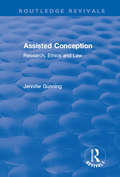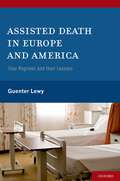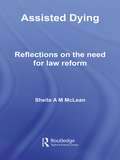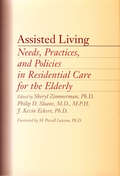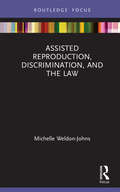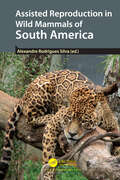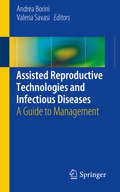- Table View
- List View
Assisted Conception: Research, Ethics and Law (Routledge Revivals)
by Jennifer GunningThis title was first published in 2003. Assisted conception is an area where it often seems that all the ethical and legal issues have been covered and then technology advances and the discussions start all over again. The book is an anthology of papers presented during a project looking at thearaputic research in assisted conception (TRAC). It is divided into three areas addressing research, ethics and law. Each chapter begins with an overview of the issues, with the aim being to present new perspectives rather than covering old ground. The European Convention on Human rights and Biomedicine came into force on December 1, 1999. The Convention allows thearaputic research and research on spare embryos but forbid fundamental research, which may be essential to the safe development of new techniques. This also means that people may become part of an experimental process without their consent. The project brings together clinicians, embryologists, lawyers and ethicists to ascertain whether there might be a risk of infertility patients being exposed to insufficiently tested procedures and to see if there is a need for fundamental research in this area. It also looks at the legislative safeguards that exist and whether a European standard for treatment should be set.
Assisted Conception: Research, Ethics and Law (Routledge Revivals)
by Jennifer GunningThis title was first published in 2003. Assisted conception is an area where it often seems that all the ethical and legal issues have been covered and then technology advances and the discussions start all over again. The book is an anthology of papers presented during a project looking at thearaputic research in assisted conception (TRAC). It is divided into three areas addressing research, ethics and law. Each chapter begins with an overview of the issues, with the aim being to present new perspectives rather than covering old ground. The European Convention on Human rights and Biomedicine came into force on December 1, 1999. The Convention allows thearaputic research and research on spare embryos but forbid fundamental research, which may be essential to the safe development of new techniques. This also means that people may become part of an experimental process without their consent. The project brings together clinicians, embryologists, lawyers and ethicists to ascertain whether there might be a risk of infertility patients being exposed to insufficiently tested procedures and to see if there is a need for fundamental research in this area. It also looks at the legislative safeguards that exist and whether a European standard for treatment should be set.
Assisted Death: A Study In Ethics And Law
by L. W. SumnerEthical and legal issues concerning physician-assisted suicide and euthanasia are very much on the public agenda in many jurisdictions. In this timely book L.W. Sumner addresses these issues within the wider context of palliative care for patients in the dying process. His ethical conclusion is that a bright line between assisted death and other widely accepted end-of-life practices, including the withdrawal of life-sustaining treatment, pain control through high-dose opioids, and terminal sedation, cannot be justified. In the course of the ethical argument many familiar themes are given careful and thorough treatment: conceptions of death, the badness of death, the wrongness of killing, informed consent and refusal, the ethics of suicide, cause of death, the double effect, the sanctity of life, the 'active/passive' distinction, advance directives, and nonvoluntary euthanasia. The legal discussion opens with a survey of some prominent prohibitionist and regulatory regimes and then outlines a model regulatory policy for assisted death. Sumner concludes by defending this policy against a wide range of common objections, including those which appeal to slippery slopes or the possibility of abuse, and by asking how the transition to a regulatory regime might be managed in three common law prohibitionist jurisdictions.
Assisted Death in Europe and America: Four Regimes and Their Lessons
by Guenter LewyAdvances in medical treatment now enable physicians to prolong life to a previously unknown extent, however in many instances these new techniques mean not the saving of life but prolonging the act of dying. In the eyes of many, medical technology has run out of control and contributes to unnecessary suffering. Hence the demand has arisen that patients should be entitled to choose death when pain and physical and mental deterioration have destroyed the possibility of a dignified and meaningful life and that their doctors should help them to realize this endeavor. At the present time there are seven jurisdictions in the world that, with various restrictions, have legalized the practice of assisted death -- physician-assisted suicide and/or voluntary euthanasia - to wit, the Netherlands, Belgium, Luxembourg, Switzerland in Europe and the states of Oregon, Washington and Montana in the United States. Four of these regimes - in the Netherlands, Belgium, Switzerland and the state of Oregon -- have been functioning for many years, and we have for them a substantial body of data as well as much observational research. This book is based upon this material. The literature dealing with the moral, legal and social aspects of assisted death is voluminous, but there is a paucity of writing that provides a detailed account of the way these four regimes are actually working. Many partisans, on both sides of the issue, cite existing data selectively or, at times, willfully distort the empirical evidence in order to strengthen their case. Based on the documentary record and interviews with officials and scholars, this book seeks to give the specialist as well as the general interested reader a reliable picture of the way assisted death functions and to draw relevant lessons. While accurate factual information cannot settle a moral debate, it nevertheless is a precondition of any well-founded argument. 'The author speaks authoritatively about the issues he addresses. I think this book does make an important contribution to the field. It will be of interest to students and scholars of PAS as a source of information and reference. I definitely recommend publication.' Stuart Youngner, Department of Bioethics, Case Western Reserve University School of Medicine 'The information collected here makes an important contribution to the literature on PAS because it collects a broad array of relevant information into a single volume. It is interesting and enlightening. This will make the book a valuable resource for anyone interested in the subject and an especially useful resource for academics who study or teach about the issues.' Rosamond Rhodes, Director, Bioethics Education, Mt Sinai School of Medicine
Assisted Death in Europe and America: Four Regimes and Their Lessons
by Guenter LewyAdvances in medical treatment now enable physicians to prolong life to a previously unknown extent, however in many instances these new techniques mean not the saving of life but prolonging the act of dying. In the eyes of many, medical technology has run out of control and contributes to unnecessary suffering. Hence the demand has arisen that patients should be entitled to choose death when pain and physical and mental deterioration have destroyed the possibility of a dignified and meaningful life and that their doctors should help them to realize this endeavor. At the present time there are seven jurisdictions in the world that, with various restrictions, have legalized the practice of assisted death -- physician-assisted suicide and/or voluntary euthanasia - to wit, the Netherlands, Belgium, Luxembourg, Switzerland in Europe and the states of Oregon, Washington and Montana in the United States. Four of these regimes - in the Netherlands, Belgium, Switzerland and the state of Oregon -- have been functioning for many years, and we have for them a substantial body of data as well as much observational research. This book is based upon this material. The literature dealing with the moral, legal and social aspects of assisted death is voluminous, but there is a paucity of writing that provides a detailed account of the way these four regimes are actually working. Many partisans, on both sides of the issue, cite existing data selectively or, at times, willfully distort the empirical evidence in order to strengthen their case. Based on the documentary record and interviews with officials and scholars, this book seeks to give the specialist as well as the general interested reader a reliable picture of the way assisted death functions and to draw relevant lessons. While accurate factual information cannot settle a moral debate, it nevertheless is a precondition of any well-founded argument. 'The author speaks authoritatively about the issues he addresses. I think this book does make an important contribution to the field. It will be of interest to students and scholars of PAS as a source of information and reference. I definitely recommend publication.' Stuart Youngner, Department of Bioethics, Case Western Reserve University School of Medicine 'The information collected here makes an important contribution to the literature on PAS because it collects a broad array of relevant information into a single volume. It is interesting and enlightening. This will make the book a valuable resource for anyone interested in the subject and an especially useful resource for academics who study or teach about the issues.' Rosamond Rhodes, Director, Bioethics Education, Mt Sinai School of Medicine
The Assisted Decision-Making Handbook
by Emma SlatteryThe Assisted Decision-Making Handbook is a one-stop resource for practice and procedure in relation to the Assisted Decision-Making (Capacity) Act 2015 (as amended) ('ADMCA') in Ireland.The ADMCA abolished the Wards of Court system and created a new system to support the decision-making of adults who may now, or in the future, lack capacity. This must-have title provides clear guidance for practitioners on what is required to bring or respond to the various types of applications which may come before the courts under the Act, including:- Capacity applications- Discharge from wardship- Review applications- Appeals from decisions of the Director of the Decision Support Service- Declarations in relation to advanced healthcare directives and designated healthcare representativesBringing together the legislation, regulations and specifications, this comprehensive handbook helps you to understand the creation and ongoing management of the support arrangements available under the ADMCA. It guides you through the process for making complaints about decision supporters and raising objections regarding decision support arrangements, as well as the fees associated with these arrangements.This book also brings together all of the relevant practical information about the ADMCA for legal practitioners, advocates, NGOs, healthcare professionals and academics.This title is included in Bloomsbury Professional's Irish Medical Law online service.
Assisted Dying: Reflections on the Need for Law Reform (Biomedical Law and Ethics Library)
by Sheila McLeanAssisted Dying explores the law relating to euthanasia and assisted suicide, tracing its development from prohibition through to the laissez faire attitude adopted in a number of countries in the 21st Century. This book provides an in-depth critique of the arguments surrounding legislative control of such practices and particularly looks into the regulatory role of the state. In the classical tradition of libertarianism, the state is generally presumed to have a remit to intervene where an individual’s actions threaten another, rather than harm the individuals themselves. This arguably leaves a question mark over the state’s determined intervention, in the UK and elsewhere, into the private and highly personal choices of individuals to die rather than live. The perceived role of the state in safeguarding the moral values of the community and the need for third party involvement in assisted suicide and euthanasia could be thought to raise these practices to a different level. These considerations may be in direct conflict with the so called right to die espoused by some individuals and groups within the community. However this book will argue that the state’s interests are and should be second to the interests that the people themselves have in choosing their own death. Assisted Dying is winner of the The Minty Prize of the Society of Authors, and winner of the Royal Society of Medicine Book Awards, 2008
Assisted Dying: Reflections on the Need for Law Reform (Biomedical Law and Ethics Library)
by Sheila McLeanAssisted Dying explores the law relating to euthanasia and assisted suicide, tracing its development from prohibition through to the laissez faire attitude adopted in a number of countries in the 21st Century. This book provides an in-depth critique of the arguments surrounding legislative control of such practices and particularly looks into the regulatory role of the state. In the classical tradition of libertarianism, the state is generally presumed to have a remit to intervene where an individual’s actions threaten another, rather than harm the individuals themselves. This arguably leaves a question mark over the state’s determined intervention, in the UK and elsewhere, into the private and highly personal choices of individuals to die rather than live. The perceived role of the state in safeguarding the moral values of the community and the need for third party involvement in assisted suicide and euthanasia could be thought to raise these practices to a different level. These considerations may be in direct conflict with the so called right to die espoused by some individuals and groups within the community. However this book will argue that the state’s interests are and should be second to the interests that the people themselves have in choosing their own death. Assisted Dying is winner of the The Minty Prize of the Society of Authors, and winner of the Royal Society of Medicine Book Awards, 2008
Assisted Eco-Driving: A Practical Guide to the Design and Testing of an Eco-Driving Assistance System (EDAS) (Transportation Human Factors)
by Craig K. Allison James M. Fleming Xingda Yan Roberto Lot Neville A. StantonThis book discusses an integrative approach combining Human Factors expertise with Automotive Engineering. It develops an in-depth case study of designing a fuel-efficient driving intervention and offers an examination of an innovative study of feed-forward eco-driving advice. Assisted Eco-Driving: A Practical Guide to the Design and Testing of an Eco-Driving Assistance System offers an examination of an innovative study of feed-forward eco-driving advice based on current vehicle and road environment status. It presents lessons, insights and utilises a documented scientific and research-led approach to designing novel speed advisory and fuel use minimisation systems suitable for combustion vehicles, hybrids and electric vehicles The audience consists of system designers and those working with interfaces and interactions, UX, human factors and ergonomics and system engineering. Automotive academics, researchers, and practitioners will also find this book of interest.
Assisted Eco-Driving: A Practical Guide to the Design and Testing of an Eco-Driving Assistance System (EDAS) (Transportation Human Factors)
by Craig K. Allison James M. Fleming Xingda Yan Roberto Lot Neville A. StantonThis book discusses an integrative approach combining Human Factors expertise with Automotive Engineering. It develops an in-depth case study of designing a fuel-efficient driving intervention and offers an examination of an innovative study of feed-forward eco-driving advice. Assisted Eco-Driving: A Practical Guide to the Design and Testing of an Eco-Driving Assistance System offers an examination of an innovative study of feed-forward eco-driving advice based on current vehicle and road environment status. It presents lessons, insights and utilises a documented scientific and research-led approach to designing novel speed advisory and fuel use minimisation systems suitable for combustion vehicles, hybrids and electric vehicles The audience consists of system designers and those working with interfaces and interactions, UX, human factors and ergonomics and system engineering. Automotive academics, researchers, and practitioners will also find this book of interest.
Assisted Human Reproduction: Psychological and Ethical Dilemmas
by Dani Singer Myra HunterWith contributions from: Eric Blyth, Ken Daniels, Julia Feast, Robert Lee, Nina Martin, Alexina McWhinnie, Derek Morgan, Clare Murray, Sharon Pettle, Claire Potter, Jim Richards and Francoise Shenfield The separation of procreation from conception has broadened notions of parenthood and created novel dilemmas. A woman may carry a foetus derived from gametes neither or only one of which came from her or her partner; or she may carry a foetus created using in vitro fertilisation (IVF) with the purpose of handing it to two other parents one, neither or both of whom may be genetically related to the prospective child. Parents may consist of single-sex couples, only one of them genetically related to the child; the prospective mother may be past her menopause; and genetic parenthood after death is now achievable. In a world increasingly reliant on medical science, how can the argument that equates traditional with natural and novel with unnatural/unethical be justified? Should there be legislation, which is notoriously slow to change, in a field driven by dazzling new possibilities at ever faster rate; particularly when restrictions differ from country to country, so that those who can afford it travel elsewhere for their treatment of choice? Whose rights are paramount - the adults hoping to build a family or the prospective child(ren)s future well being? On what basis can apparently competing rights be regulated or adjudicated and how and to what extent can these be enforced in practice?
Assisted Living: Sobering Realities
by Benyamin SchwarzLearn how to make elder housing more homelike!Taking an incisive look at assisted living for the elderly, Assisted Living: Sobering Realities is an important book for the professionals who work with aging Americans and their families. This vital book provides a multidisciplinary overview of the world of assisted living for older Americans. With unique insight and a keen clinical perspective, Assisted Living examines a variety of topics: the dilemma of aging in place, the realities of end-of-life care, and the ins and outs of residential care supply. Easy-to-read graphs and charts make the data user-friendly.This book delivers current information on: the housing needs of elderly renters, with case studies of 109 residents in two facilities the need for improved housing and services for low-income elderly, providing an overview of how successful facilities take a comprehensive approach in linking low-income elders with community-based services the advantages and disadvantages of residential care facilities research about aging in place from providers and residents&’ perspectives the unmet needs of the elderly who qualify for housing assistance how visitation patterns affect the overall satisfaction and quality of life of assisted living residents
Assisted Living: Sobering Realities
by Benyamin SchwarzLearn how to make elder housing more homelike!Taking an incisive look at assisted living for the elderly, Assisted Living: Sobering Realities is an important book for the professionals who work with aging Americans and their families. This vital book provides a multidisciplinary overview of the world of assisted living for older Americans. With unique insight and a keen clinical perspective, Assisted Living examines a variety of topics: the dilemma of aging in place, the realities of end-of-life care, and the ins and outs of residential care supply. Easy-to-read graphs and charts make the data user-friendly.This book delivers current information on: the housing needs of elderly renters, with case studies of 109 residents in two facilities the need for improved housing and services for low-income elderly, providing an overview of how successful facilities take a comprehensive approach in linking low-income elders with community-based services the advantages and disadvantages of residential care facilities research about aging in place from providers and residents&’ perspectives the unmet needs of the elderly who qualify for housing assistance how visitation patterns affect the overall satisfaction and quality of life of assisted living residents
Assisted Living: Needs, Practices, and Policies in Residential Care for the Elderly
by Sheryl ZimmermanWith the number of elderly persons needing long-term care expected to double to 14 million over the next two decades, assisted living has become the popular choice for housing or care. Assisted living represents a promising model of long-term care that blurs the sharp distinction between nursing homes and community-based care and reduces the gap between receiving long-term care in one's own home and in an "institution." Assisted Living: Needs, Practices, and Policies in Residential Care for the Elderly examines the evolving field of residential care and focuses on national issues of regulation, reimbursement, and staffing. The book is based on a four-state study of assisted living facilities and describes the facilities, the persons residing in them and their needs, and how the services vary by facility. Because one-third to two-thirds of residents in assisted living facilities have cognitive impairment, special attention is devoted to dementia care. The book also focuses on how today's long-term health care environment evolved, and it examines the future direction and implications of assisted living.Assisted Living: Needs, Practices, and Policies in Residential Care for the Elderly brings together a group of nationally recognized experts to help define the types of residential care that should be encouraged and sets guidelines for selecting an appropriate type of facility.
Assisted Reproduction Across Borders: Feminist Perspectives on Normalizations, Disruptions and Transmissions (Routledge Advances in Feminist Studies and Intersectionality)
by Merete Lie Nina LykkeToday, it often seems as though Assisted Reproductive Technologies (ARTs) have reached a stage of normalization, at least in some countries and among certain social groups. Apparently some practices – for example in vitro fertilization (IVF) – have become standard worldwide. The contributors to Assisted Reproduction Across Borders argue against normalization as an uncontested overall trend. This volume reflects on the state of the art of ARTs. From feminist perspectives, the contributors focus on contemporary political debates triggered by ARTs. They examine the varying ways in which ARTs are interpreted and practised in different contexts, depending on religious, moral and political approaches. Assisted Reproduction Across Borders embeds feminist analysis of ARTs across a wide variety of countries and cultural contexts, discussing controversial practices such as surrogacy from the perspective of the global South as well as the global North as well as inequalities in terms of access to IVF. This volume will appeal to scholars and students of anthropology, ethnography, philosophy, political science, history, sociology, film studies, media studies, literature, art history, area studies, and interdisciplinary areas such as gender studies, cultural studies, and postcolonial studies.
Assisted Reproduction Across Borders: Feminist Perspectives on Normalizations, Disruptions and Transmissions (Routledge Advances in Feminist Studies and Intersectionality)
by Merete Lie Nina LykkeToday, it often seems as though Assisted Reproductive Technologies (ARTs) have reached a stage of normalization, at least in some countries and among certain social groups. Apparently some practices – for example in vitro fertilization (IVF) – have become standard worldwide. The contributors to Assisted Reproduction Across Borders argue against normalization as an uncontested overall trend. This volume reflects on the state of the art of ARTs. From feminist perspectives, the contributors focus on contemporary political debates triggered by ARTs. They examine the varying ways in which ARTs are interpreted and practised in different contexts, depending on religious, moral and political approaches. Assisted Reproduction Across Borders embeds feminist analysis of ARTs across a wide variety of countries and cultural contexts, discussing controversial practices such as surrogacy from the perspective of the global South as well as the global North as well as inequalities in terms of access to IVF. This volume will appeal to scholars and students of anthropology, ethnography, philosophy, political science, history, sociology, film studies, media studies, literature, art history, area studies, and interdisciplinary areas such as gender studies, cultural studies, and postcolonial studies.
Assisted Reproduction, Discrimination, and the Law: Conceiving a New Interpretation of Equality
by Michelle Weldon-JohnsThe numbers of women undergoing Assisted Reproduction Technology (ART) treatments have risen steadily, yet they remain largely outside the scope of equality and employment law protection while undergoing treatment. Assisted Reproduction, Discrimination, and the Law examines this gap in UK law, with reference to EU law as appropriate, and argues that new conceptions of equality are necessary. Drawing from the literature on multidimensional and intersectional discrimination, it is argued that an intersectionality approach offers a more useful analytical framework to extend protection to those engaged in ART treatments. Drawing from Schiek’s intersectional nodes model, the book critically examines two alternative interpretations of existing protected characteristics, namely infertility as a disability, with reference to the social model of disability and the UN Convention on the Rights of Persons with Disabilities 2006, and redefining the boundaries of pregnancy and/or sex discrimination, with reference to attempts to extend associative discrimination to pregnancy. Comparisons are drawn with the US, where infertility has been recognised as a disability under the American’s with Disabilities Act 1990 and as a pregnancy-related condition under the Pregnancy Discrimination Act 1978. A specific right to paid time off work to undergo treatment is also proposed, drawing comparisons with the US Family and Medical Leave Act 1993 and the existing UK work-family rights framework. It is argued that the reinterpretations of equality law and the rights proposed here are not only conceptually possible, but could practically be achieved with minor, but significant, amendments to existing legislation.
Assisted Reproduction, Discrimination, and the Law: Conceiving a New Interpretation of Equality
by Michelle Weldon-JohnsThe numbers of women undergoing Assisted Reproduction Technology (ART) treatments have risen steadily, yet they remain largely outside the scope of equality and employment law protection while undergoing treatment. Assisted Reproduction, Discrimination, and the Law examines this gap in UK law, with reference to EU law as appropriate, and argues that new conceptions of equality are necessary. Drawing from the literature on multidimensional and intersectional discrimination, it is argued that an intersectionality approach offers a more useful analytical framework to extend protection to those engaged in ART treatments. Drawing from Schiek’s intersectional nodes model, the book critically examines two alternative interpretations of existing protected characteristics, namely infertility as a disability, with reference to the social model of disability and the UN Convention on the Rights of Persons with Disabilities 2006, and redefining the boundaries of pregnancy and/or sex discrimination, with reference to attempts to extend associative discrimination to pregnancy. Comparisons are drawn with the US, where infertility has been recognised as a disability under the American’s with Disabilities Act 1990 and as a pregnancy-related condition under the Pregnancy Discrimination Act 1978. A specific right to paid time off work to undergo treatment is also proposed, drawing comparisons with the US Family and Medical Leave Act 1993 and the existing UK work-family rights framework. It is argued that the reinterpretations of equality law and the rights proposed here are not only conceptually possible, but could practically be achieved with minor, but significant, amendments to existing legislation.
Assisted Reproduction in Wild Mammals of South America
by Alexandre Rodrigues SilvaSouth America has one of the greatest riches in the world in terms of biodiversity. Despite all this richness, recent reports warn of different threats to this biodiversity. As a strategy to reduce the rate of loss of animal species, the development and application of assisted reproduction techniques (ARTs) for their conservation currently stands out. Thus, this book compiles information on recent scientific studies regarding the development of ARTs for the conservation of wild mammalian species in South America, thus serving as an important source of reference for professionals and students interested in wildlife conservation.
Assisted Reproduction in Wild Mammals of South America
South America has one of the greatest riches in the world in terms of biodiversity. Despite all this richness, recent reports warn of different threats to this biodiversity. As a strategy to reduce the rate of loss of animal species, the development and application of assisted reproduction techniques (ARTs) for their conservation currently stands out. Thus, this book compiles information on recent scientific studies regarding the development of ARTs for the conservation of wild mammalian species in South America, thus serving as an important source of reference for professionals and students interested in wildlife conservation.
Assisted Reproduction Techniques: Challenges and Management Options
by Arri Coomarasamy Khaldoun SharifAssisted reproduction techniques have led to the birth of 4 million babies worldwide Assisted reproduction techniques (ART), in particular in-vitro fertilization and intra-cytoplasmic sperm injection, are the most advanced forms of infertility treatment. They involve numerous counseling, medical, surgical and laboratory-based steps. At each step various problems and complications could be encountered that challenge even the most experienced ART practitioners. Moreover, patients with complex medical disorders may require ART, presenting further challenges. Assisted Reproduction Techniques will stimulate resourceful thinking in the ART practitioner when faced with these challenges. It outlines various management options, the reasoning behind them, and the evidence on which they are based to enable the practitioner to choose the most suitable solution for the needs of each patient. Written by 122 internationally renowned experts, Assisted Reproduction Techniques follows the patient's journey throughout the whole ART process, with chapters on: Counseling and preparation Ovarian stimulation Oocyte retrieval Embryo transfer The luteal phase The ART laboratory The male patient The ART pregnancy Each of the 100 concise chapters includes clinical cases, background, evidence-based practical management options, preventive measures and key-point summaries of the important details. Assisted Reproduction Techniques gives a wide-ranging practical guide to all those wishing to support couples who cannot conceive naturally.
Assisted Reproduction Techniques: Challenges and Management Options
by Khaldoun Sharif Arri CoomarasamyAssisted reproduction techniques have led to the birth of 4 million babies worldwide Assisted reproduction techniques (ART), in particular in-vitro fertilization and intra-cytoplasmic sperm injection, are the most advanced forms of infertility treatment. They involve numerous counseling, medical, surgical and laboratory-based steps. At each step various problems and complications could be encountered that challenge even the most experienced ART practitioners. Moreover, patients with complex medical disorders may require ART, presenting further challenges. Assisted Reproduction Techniques will stimulate resourceful thinking in the ART practitioner when faced with these challenges. It outlines various management options, the reasoning behind them, and the evidence on which they are based to enable the practitioner to choose the most suitable solution for the needs of each patient. Written by 122 internationally renowned experts, Assisted Reproduction Techniques follows the patient's journey throughout the whole ART process, with chapters on: Counseling and preparation Ovarian stimulation Oocyte retrieval Embryo transfer The luteal phase The ART laboratory The male patient The ART pregnancy Each of the 100 concise chapters includes clinical cases, background, evidence-based practical management options, preventive measures and key-point summaries of the important details. Assisted Reproduction Techniques gives a wide-ranging practical guide to all those wishing to support couples who cannot conceive naturally.
Assisted Reproduction Techniques: Challenges and Management Options
by Khaldoun Sharif Arri CoomarasamyAssisted reproduction techniques have led to the birth of 8 million babies worldwide Assisted reproduction techniques (ART), in particular in-vitro fertilization and intra-cytoplasmic sperm injection, are the most advanced forms of infertility treatment. They involve numerous counseling, medical, surgical and laboratory-based steps. At each step various problems and complications could be encountered that challenge even the most experienced ART practitioners. Moreover, patients with complex medical disorders may require ART, presenting further challenges. Assisted Reproduction Techniques will stimulate resourceful thinking in the ART practitioner when faced with these challenges. It outlines various management options, the reasoning behind them, and the evidence on which they are based to enable the practitioner to choose the most suitable solution for the needs of each patient. Written by 171 internationally renowned experts, Assisted Reproduction Techniques follows the patient's journey throughout the whole ART process, with chapters on: Counseling and preparation Pituitary suppression and ovarian stimulation Oocyte retrieval Embryo transfer The luteal phase The ART laboratory The male patient The ART pregnancy <li style="margin: 0in 0in 0in 0.75in; font-size: 11pt; font-family: Calibri, sans-serif; text-align: justify; vertical-align: baseline; user-select: text; -webkit-user-drag: none; -webkit-tap-highlight-color: transparent; cur
Assisted Reproduction Techniques: Challenges and Management Options
Assisted reproduction techniques have led to the birth of 8 million babies worldwide Assisted reproduction techniques (ART), in particular in-vitro fertilization and intra-cytoplasmic sperm injection, are the most advanced forms of infertility treatment. They involve numerous counseling, medical, surgical and laboratory-based steps. At each step various problems and complications could be encountered that challenge even the most experienced ART practitioners. Moreover, patients with complex medical disorders may require ART, presenting further challenges. Assisted Reproduction Techniques will stimulate resourceful thinking in the ART practitioner when faced with these challenges. It outlines various management options, the reasoning behind them, and the evidence on which they are based to enable the practitioner to choose the most suitable solution for the needs of each patient. Written by 171 internationally renowned experts, Assisted Reproduction Techniques follows the patient's journey throughout the whole ART process, with chapters on: Counseling and preparation Pituitary suppression and ovarian stimulation Oocyte retrieval Embryo transfer The luteal phase The ART laboratory The male patient The ART pregnancy <li style="margin: 0in 0in 0in 0.75in; font-size: 11pt; font-family: Calibri, sans-serif; text-align: justify; vertical-align: baseline; user-select: text; -webkit-user-drag: none; -webkit-tap-highlight-color: transparent; cur
Assisted Reproductive Technologies and Infectious Diseases: A Guide to Management
by Andrea Borini Maria Valeria SavasiThis concise and practical book is the first of its kind to examine the use of assisted reproductive technologies (ART) in relation to blood-borne infectious diseases: human immunodeficiency virus (HIV), hepatitis B (HBV) and hepatitis C (HCV). The book opens with a discussion of the impact of these viruses on male and female fertility, followed by specific chapters of each of them, including ART with HIV and HCV serodiscordant couples (where either the male or female is positive) and the detection and impact of HBV and HCV in human gametes and embryos. An important character on laboratory safety when performing ART with blood-borne viruses follows, and the book concludes with a discussion of ART in austere and resource-poor settings, where these infections are often dominant due to lack of treatment and access to vaccines. Written and edited by an international array of experts in reproductive medicine, Assisted Reproductive Technologies and Infectious Diseases explores questions, techniques, and related issues with the aim of effectively helping clinicians working with serodiscordant couples wishing to have children.
